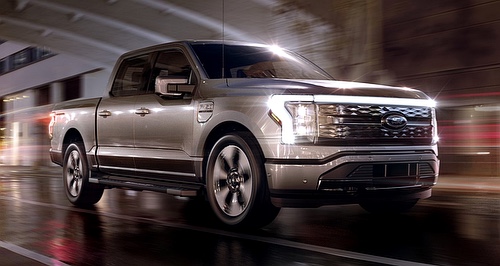Make / Model Search
News - Ford - F-150 - LightningFord eyes new battery tech, cuts jobsNEW TECH: Ford's all-electric F-150 Lightning is one of the models that stands to benefit from new battery technology. LIP batteries to reduce costs for Ford as 8000 jobs cut from ICE division22 Jul 2022 By MATT BROGAN FORD Motor Company will add new battery cell chemistry to its EV portfolio to increase capacity and make its EVs cheaper to build – the same week the brand announced salaried job cuts of up to 8000 staff from its ICE division, Ford Blue, according to a report published by Automotive News Europe (ANE).
The company says it plans to add lithium iron phosphate (LIP) cells to its Mustang Mach-E from next year and to F-150 Lightning models from 2024, a move it says will reduce material costs by as much as 15 per cent.
Ford currently uses nickel cobalt manganese battery packs for its Mustang and F-Truck EVs, and in its E-Transit van.
The chemistry switch is one of several battery-related initiatives Ford announced this week as it pushes to increase global EV production to 600,000 units by the end of next year – including 270,000 Mustang Mach-Es, 150,000 F-150 Lightnings, 150,000 E-Transits and 30,000 examples of a “new SUV for Europe” – and two million units by 2026.
Ford CEO Jim Farley told ANE that is has already secured all of the battery cell capacity needed for its 2023 target and has 70 per cent of what it requires to meet is 2026 goal.
“Ford’s new electric vehicle line-up has generated huge enthusiasm and demand, and now we are putting the industrial system in place to scale quickly,” said Mr Farley.
“Our Model e team has moved with speed, focus and creativity to secure the battery capacity and raw materials we need to deliver breakthrough EVs for millions of customers.”
Mr Farley said Contemporary Amperex Technology Limited (CATL) will provide the lithium iron phosphate battery packs for Ford’s Mustang Mach-E and F-150 Lightning, but that it will continue to collaborate with current suppliers LG Energy Solution and SK Innovation.
Ford told ANE it plans to localise and use 40 gigawatt hours of lithium iron phosphate cell capacity in North America from 2026 and that it has signed a non-binding memorandum of understanding with CATL to “explore cooperation” for supplying batteries across its North American plants.
The manufacturer said previously that it plans to invest of $US50 billion ($A72.8b) in electric vehicle technology through to 2026 and is targeting company adjusted earnings (before interest and taxes) of 10 per cent, with eight per cent margins for EVs.
The news comes just a day after a report from Bloomberg outlined Ford’s plans to cut up to 8000 salaried jobs in the coming weeks as it works to fund its EV efforts. The cuts are expected to come from the division known as Ford Blue, which is responsible for internal combustion vehicles.
Likely to begin within the coming months, the job cuts are part of a reshaping of the organisation, Ford CCO Mark Truby saying the company must capitalise on the growth of the electric vehicle market.
“As part of this, we have laid out clear targets to lower our cost structure to ensure we are lean and fully competitive with the best in the industry,” he said.
Ford share values have fallen 39 per cent since the start of the year amid inflation fears and supply-chain bottlenecks affecting most of the industry.
Ford CEO Jim Farley said the job cuts were necessary to help finance the company’s EV ambitions and to boost profits the company has lost to the development of the Mustang Mach-E and other plug-in models amid rising commodity and warranty costs.
“We have too many people (and) this management team firmly believes that our ICE and BEV portfolios are under-earning,” said Mr Farley.
“The funding for that $50 billion, it’s all based on our core automotive operations. That’s why we created a separate group called Ford Blue, because we need them to be more profitable to fund this.”
With Bloomberg and Automotive News Europe  Read more |
Click to shareFord articlesResearch Ford Motor industry news |












Facebook Twitter Instagram